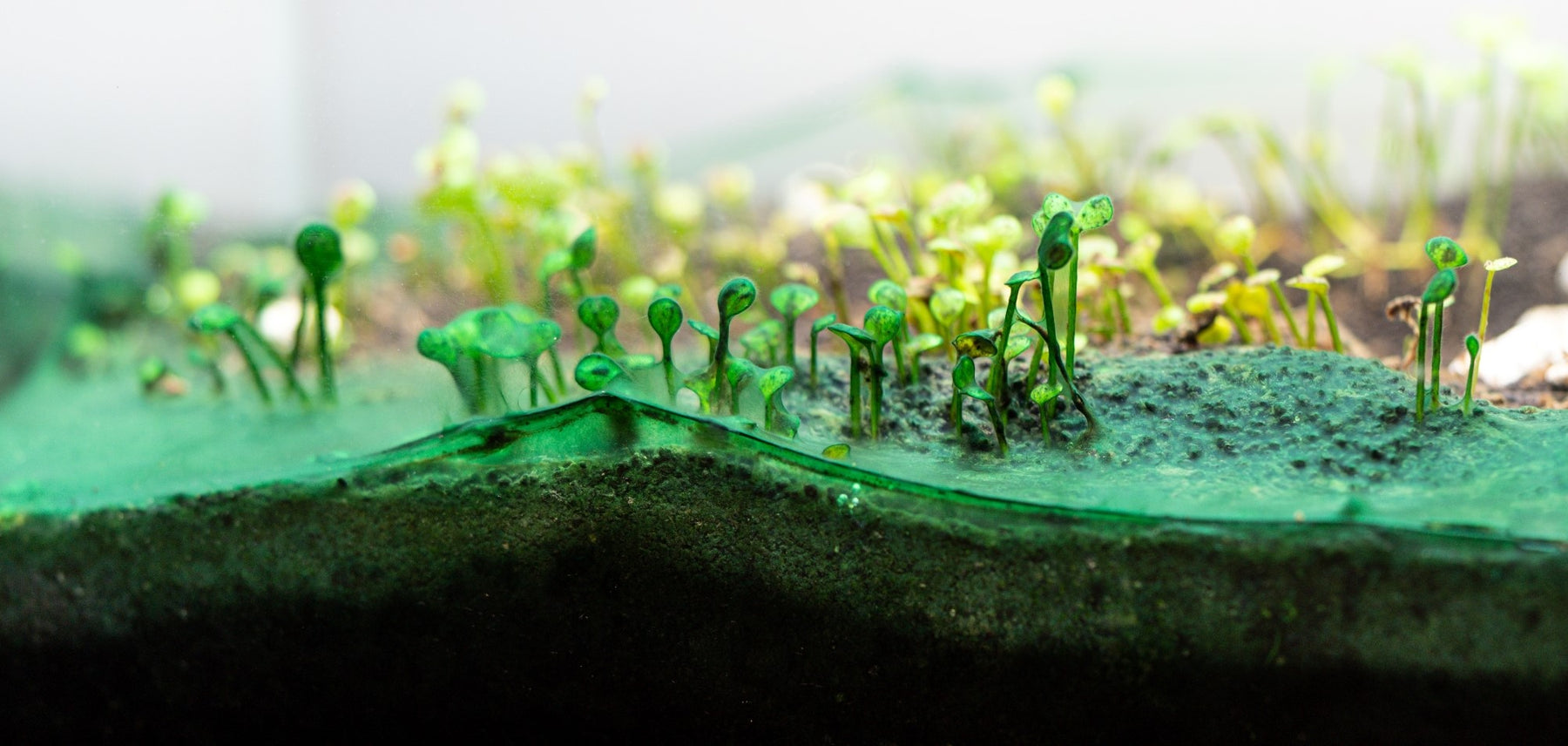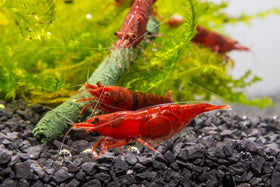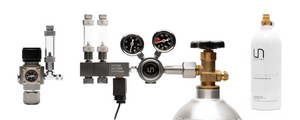
How to Get Rid of Cyanobacteria in Aquariums
If your freshwater aquarium has been taken over by a thick layer of blueish-green algae, you may be dealing with a cyanobacteria outbreak. There are a wide range of causes behind cyanobacteria (commonly referred to as blue-green algae) such as poor water flow, buildup of organic waste, and nutrient imbalance.
In this comprehensive guide, we'll demystify the issue of cyanobacteria in planted aquariums. Fortunately, numerous effective solutions are available to help you eradicate the issue from your freshwater aquarium.
This article will explore the root causes of cyanobacteria and its impact on the natural balance of an aquatic ecosystem. Continue reading to discover how to identify and eliminate cyanobacteria blooms for a healthy, thriving planted tank.
This article will go over:
- What is Cyanobacteria (Blue-Green Algae)?
- What Causes Cyanobacteria?
- How to Remove Cyanobacteria
- How to Prevent Cyanobacteria
- Notes on Dealing with Cyanobacteria
What Is Cyanobacteria?
Cyanobacteria, also known as blue-green algae, often looks like a slimy blueish-green coating that covers substrate and aquarium decor. It can also hinder the growth of live aquatic plants in your aquarium. Cyanobacteria often has a pungent odor that is quite foul and earthy-smelling.
While often mistaken as algae, cyanobacteria is characterized as a diverse group of photosynthetic bacteria that use light to create food, the same way plants do. These simple microorganisms often multiply quickly when there are too many nutrients in the water. This usually happens because of overfeeding or poor water quality.
Treating a cyanobacteria outbreak immediately after identifying it is crucial to stopping its spread. Although fish are usually unharmed, cyanobacteria can hinder plant growth and possibly lead to the death of plants. If it overtakes a plant's leaves, it cannot undergo photosynthesis.

What Causes Cyanobacteria?
A few different causes might explain cyanobacteria blooms. A common theme is that these blooms tend to happen in stagnant and nutrient-rich bodies of water. In aquariums, blue-green algae often appear in spots where there is leftover organic waste, like uneaten fish food.The various causes of cyanobacteria include:
1. Imbalance in Nutrient Levels
One of the primary triggers for cyanobacteria outbreaks is an imbalance in nutrient levels. Cyanobacteria can easily take hold of an aquarium when there is an excess of essential nutrients like nitrogen and phosphorus in the water column.
To combat future outbreaks of any algal bloom, ensure you don't overfeed your fish. Perform regular water testing over the long term is essential to maintain the delicate nutrient balance in your aquarium. Additionally, consider adding nutrient-absorbing live plants to help keep levels within a healthy range.
- Tip: Floating plants or fast-growing stem plants are great choices for absorbing excess nutrients in an aquarium. We recommend Salvinia Cucullata or Egeria Densa.
2. Poor Water Circulation and Oxygenation
Stagnant water is an ideal breeding ground for future outbreaks. Poor water circulation prevents essential nutrients from reaching all areas of the tank, fostering the growth of cyanobacteria.
Ensure you have a quality filter for your aquarium with an acceptable flow rate for your tank size. You can also invest in a water pump and strategically position it to ensure optimal circulation. Adequate oxygenation is equally vital, as cyanobacteria struggle to thrive in well-oxygenated environments. Regular water changes and aeration devices can make a significant difference in the occurrence and frequency of future outbreaks.
3. Organic Matter Buildup in Substrate
Neglecting the aquarium substrate is another common mistake of hobbyists who find themselves battling an infestation. Organic matter, such as uneaten food and decaying plant material, accumulates over time in the substrate bed. This provides cyanobacteria with a rich source of nutrients.
Regular vacuuming of the substrate during water changes can help eliminate this breeding ground. However, it's best to vacuum substrate only every 1-2 months to prevent disrupting the helpful bacteria colonies crucial for your system's natural biological filtration.

How to Remove Cyanobacteria
Fortunately, there are multiple treatment options designed to eliminate blue-green algae. These methods range from manual removal to chemical additives, and even the types of plants you choose to aquascape with. Successful eradication of cyanobacteria often requires a combination of manual intervention and fine-tuning of the aquarium setup.The various methods of removing cyanobacteria include:
1. Manual Removal
The first step in dealing with a cyanobacteria bloom is to manually remove as much of it as possible. To manually remove algae, gently scrub affected surfaces with a toothbrush or algae scraper, and siphon out as much as possible during water changes. At a minimum, perform weekly water changes to remove excess nutrients. To keep the water clean, regularly clean the filter and reduce the amount of fish food.
- Tip: Be sure to thoroughly clean all aquascaping tools that come in contact with the affected tank to avoid spreading the outbreak to other systems.
Consider increasing your aquarium's water flow and oxygenation to improve water circulation and eliminate dead spots within the tank. Also, consider a higher quality filtration system, which is essential to clearing debris and excess nutrients. This is important to foster an environment that is unfavorable to cyanobacteria growth. In addition to a better filtration system, a powerhead can play a crucial role in the prevention of cyanobacteria.
3. Adjust Photoperiod
Cyanobacteria, like live plants, also use photosynthesis to turn light into energy. This means controlling light exposure is crucial to limiting the occurrence of blue-green algae blooms. Adjust the intensity and duration of your aquarium lighting to discourage future outbreaks. A consistent photoperiod helps establish a natural rhythm, promoting the overall wellness and stability of your aquarium's ecosystem.
If all else fails, simply turn off all aquarium lights for 3 to 7 days. This will starve the cyanobacteria of the light it requires to grow. While this approach can work, potential drawbacks include harm to plants, which also rely on photosynthesis. Additionally, the resurgence of blue-green algae can happen within a few weeks, diminishing the effectiveness of this method.
4. Chemical Treatments
Fortunately, cyanobacteria can be effectively treated with the antibiotic erythromycin. This treatment is safe for fish, plants, and invertebrates and does not harm the beneficial bacteria in your freshwater tank. We also recommend Green Water Labs Algae Control, which is specially formulated to target and eliminate cyanobacteria without causing harm to the rest of your aquarium.
Follow the instructions on how to use Green Water Labs Algae Control to eliminate cyanobacteria:
- To begin the treatment process, start by diligently scrubbing off and siphoning up as much of the cyanobacteria as possible. Perform thorough maintenance and a water change before dosing Algae Control. If needed, vacuum your substrate during your water change.
- Following substrate vacuuming and tank refilling, fill a syringe with the proper dosing of Algae Control for your tank (2oz per 10 gallons). Then, dose directly onto problem areas.
- Continue this process weekly following water changes.
- Please expect up to 2-4 weeks of regular dosing after water changes before you see results. In cases where the blue-green algae is notably thick and widespread, repeating the treatment multiple times may be necessary for complete colony removal.
Follow dosing instructions diligently, and be aware of potential impacts on your fish, plants, and the overall aquarium ecosystem. Closely monitor their impact on your fish and plants before, during, and after dosing. Only consider different chemical treatments, like algaecides and antibiotics, as a last resort after trying manual removal and natural alternatives.
How to Prevent Cyanobacteria
Fortunately, a prevention-based approach can shield you from ever having to deal with the issue of blue-green algae. Several practical strategies have been proven to keep cyanobacteria at bay.The various methods of preventing cyanobacteria include:
1. Proper Aquarium Setup and Maintenance
Preventing cyanobacteria starts with a strategic and thought-out aquarium setup. Ensure your tank has the appropriate filtration and lighting requirements for the inhabitants. Establish a routine maintenance schedule, including regular weekly water changes and monthly substrate vacuuming. Consistent, proactive care lays the foundation for a thriving aquarium that is less susceptible to cyanobacteria outbreaks.
- Tip: When doing maintenance, make sure to clean all tools that touch the affected tank thoroughly afterward to prevent spreading cyanobacteria to other setups.
2. Monitoring and Controlling Nutrient Levels
Regular water testing is your first line of defense against cyanobacteria. Test for ammonia, nitrites, nitrates, and phosphates to maintain optimal nutrient levels. Adjust feeding habits accordingly, being mindful not to overfeed. Introduce nutrient-absorbing freshwater plants like Hornwort or floating plants to help maintain a healthy nutrient balance within the aquarium.
3. Implementing Effective Water Circulation and Filtration Systems
Investing in a reliable water pump and a well-designed filtration system is critical in preventing cyanobacteria. Ensure that water circulates evenly throughout the tank, reaching all corners and preventing stagnation. A powerful filtration system removes debris and excess nutrients, creating an environment that isn't conducive to cyanobacteria growth.
4. Introduce Cyanobacteria-Resistant Plants
Selecting freshwater aquarium plants that are naturally resistant to cyanobacteria can play a crucial role in the prevention of blue-green algae. Species like Vallisneria and Hornwort are known for their resilience against cyanobacteria. These fast-growing species not only produce oxygen but absorb excess nutrients. This results in greater competition for resources and less opportunity for cyano to spread.
Slower-growing plants are often outcompeted and overtaken by blue-green algae because it is quicker to utilize nutrients in the water column. Introduce a few of these resistant species into your tank to create a vibrant, yet hardy, aquascape.

Notes on Dealing with Cyanobacteria
Recognize that the time and effort you put into your aquarium will result in a vibrant and thriving aquatic ecosystem. Every challenge is a chance for growth, learning, and, in the end, a more beautiful and balanced environment for both your fish and your enjoyment.
For any dedicated aquarist, maintaining a healthy aquatic ecosystem is crucial for the well-being of fish and plants. This comprehensive guide delves into the causes of cyanobacteria, its impact on an aquarium, and practical solutions for treatment and prevention. Dialing in your light and nutrient levels is key to eliminating cyanobacteria. Armed with the knowledge from this article and employing a multifaceted treatment approach, handling cyanobacteria issues is achievable.
Tell us - Was this article helpful? Please leave a comment below!
If you have any questions regarding this article, please email support@buceplant.com, or DM us on Instagram or Facebook so we can assist you directly - @buceplant






Comments
Leave a comment